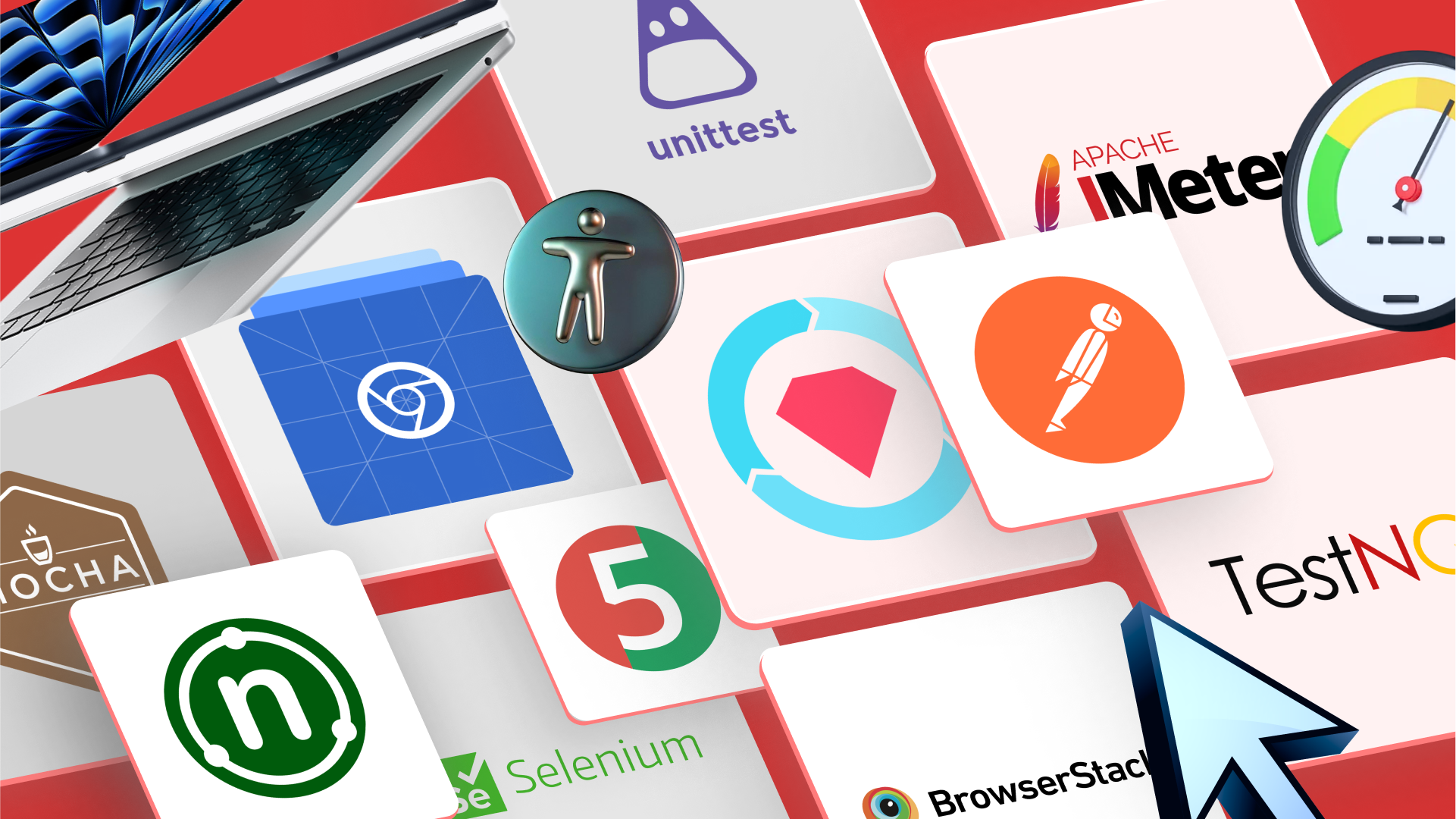Do you remember how the websites looked just ten years ago? Our web experience was rather limited. Each passing year, websites are becoming more complex, with functionalities that were once unimaginable.
But here’s the catch: the more intricate a website becomes, the more susceptible it is to defects and vulnerabilities that can potentially distract users and harm the site’s overall reputation. In order to minimize these dangers, every website, without exception, must undergo thorough testing.
So, how do we go about testing a website? Which web testing tools should we use? In this article, we’ll review the best website testing tools and also talk about the following:
How to Choose Website Testing Tools?
Selecting the right website testing software can be a daunting task. It involves weighing several critical factors, including the size and complexity of your software project, the expertise of your QA team, and the requirements and deadlines set by your client.
Let’s delve into the key aspects in detail:
- Choose your testing strategy. Decide on your focus: manual testing, automated testing, or a combination of the two. It will help you identify the tools that best suit your testing approach.
- Specify your requirements and needs. Define your testing goals, objectives, and the specific types of tests you need to perform on your website. Consider elements such as automation capabilities, functionality testing, performance testing, usability testing, security testing, and compatibility testing.
- Set a budget. Explore both open-source and paid alternatives. Take into account all the expenses tied to the tools, including licensing fees, maintenance charges, and any additional costs for support or training. Analyze the tool’s pricing model to ensure it aligns with your budget and long-term requirements.
- Consider your team’s skillset. Do you have experienced testers on board with the necessary skills for the required tool stack? How fast will they be able to master the tool?
- Pay due attention to the platforms and technologies the tool supports. Think about aspects such as tool features, the technology stack, and integration potential. Check which platforms the tool is compatible with for running tests.
Although the research may take some time, the benefits of using the best tool for testing your website will make it worthwhile.
Top 11 Website Testing Tools
As a respected provider of web application testing services, we understand that the right tools help increase the quality and speed of testing. Drawing upon 8-plus years of experience in QA and a diverse project portfolio, we have compiled a list of web testing tools to help you select the one that aligns best with your testing requirements.
Below, we present the top 11 tools for testing web applications, highlighting their key features, benefits, drawbacks, and pricing details. Let’s describe them in a more thorough fashion!
BrowserStack offers three solutions for website testing to QA experts: Live (for cross-browser testing), Automate (for Selenium testing), and Percy (for visual testing). It also supports mobile application testing. With BrowserStack, you can conduct tests on several thousand real devices and browsers, eliminating the need for simulators and emulators and significantly enhancing the user experience.
Our QA engineers used BrowserStack to thoroughly test Penpot on Firefox, Chrome, and Safari. We paid special attention to various Safari versions, addressing bugs that surfaced in older ones. We tested Penpot on Windows, macOS, and Linux to ensure a seamless experience across all devices for users.
- Instant access to 3000+ real devices and browsers
- Increased visual coverage
- Real-time debugging
- Running tests in parallel
- High security and privacy
- Responsive design testing
- Screenshot testing
- Website speed testing
- Integration with GitHub, Jira, Slack, Selenium, TestProject, Netlify, and more
- Free trial
- May be relatively expensive (pricing depends on your specific needs)
- No option to add custom devices
“I found BrowserStack to be super user-friendly for running automation tests. It’s a simple and convenient tool with lightning-fast testing speed. BrowserStack helped us perform compatibility testing across various browsers and devices. The best part? You can switch between devices during a single session, including mobile and web!”
Originally, Apache JMeter, an open-source Java application, was designed for testing web applications. Since then, its set of features has expanded, enabling QA professionals to conduct load tests on functional behavior, simulate heavy loads, and measure performance under various load conditions.
QAwerk used Apache JMeter when conducting load testing for the Couple Up! mobile game. We examined the performance of one GET and three POST API calls under different load conditions. We encountered an issue with API header descriptions, which we resolved by creating a script to accurately describe the requests in JMeter.
- Support for both static and dynamic resources
- Compatibility with various applications, servers, and protocols (HTTP, HTTPS, etc.)
- Test plan recording, construction, and debugging
- Ability to conduct load tests from any Java-compatible operating system
- Dynamic HTML reporting
- Data extraction capabilities from HTML, JSON, XML, or any textual format
- Complete portability
- Comprehensive multithreading framework
- Caching and offline analysis/replaying of test results
- Availability of data analysis and visualization plugins
- Some browser-supported actions cannot be executed
- It’s crucial to verify the integrity of downloaded files using signatures obtained from the main distribution directories
- It may be difficult for novice testers to use
“Apache JMeter is great for stress testing and simulating user overload. The best part is, it allows you to maintain concurrent loads and run numerous threads to thoroughly test your application or server capacity. It provides a detailed report of your load testing results.”
Selenium is an open-source software, providing three solutions that QA experts can utilize. Selenium WebDriver enables the creation of browser-based regression automation suites and tests, as well as the ability to scale and distribute scripts across various environments.
Selenium IDE allows you to create bug reproduction scripts and scripts for use in automation-assisted exploratory testing. Selenium will speed up your work and simplify it. In fact, it’s the solution that lets you distribute and run tests on multiple machines while simultaneously managing several environments.
- Test case creation
- Test automation
- Bug reproduction script development
- Script creation for automation-assisted exploratory testing
- Running tests in parallel
- Cross-platform testing
- Test debugging
- Reusable test cases
- Plugin support
- Load balancing
- No reporting feature
- No image comparison feature
- No support for codeless testing
Chrome DevTools is an entire set of web developer tools built into Google Chrome that allows for website iteration and debugging. These tools are free to use and offer numerous features that QA experts can benefit from.
- Device orientation simulation
- JavaScript debugging
- Website speed optimization
- Debugging progressive web apps
- Testing HTTPS implementation
- Identifying and fixing memory issues
- Detecting performance bottlenecks
- Inspecting CSS grids
- Inspecting animations
- Detecting cookie and mixed content issues
- High memory usage
- May be too complex for novice developers and testers due to its intricate layout and wide range of functions
Postman is a platform that accelerates and simplifies the API lifecycle, enabling you to create APIs faster and more effectively. The platform provides a comprehensive set of tools that you can leverage for API testing, designing API specifications, generating documentation, creating mock servers, monitoring API performance, and capturing requests and responses.
QAwerk relied on Postman when manually testing the Union54 RESTful API. It proved particularly useful since our application lacked a frontend. Our goal was to make sure it gives the correct results, has strong security features, and performs effectively.
- Writing test scripts
- Using snippets
- Testing collections and folders
- Building APIs
- Deploying APIs
- Capturing HTTP requests
- Generating reports
- Receiving security warnings
- Utilizing the automatic documentation feature
- Setting up mock servers
- May be complex for new users
- Limited automation capabilities
“Postman’s user interface is perfectly tailored to its purpose, and I feel comfortable using it. The actions I perform work seamlessly without requiring extensive research. Postman enables us to access and edit various request types, headers, parameters, and authentication methods effortlessly. It facilitates the simple sharing of collections, environments, and documentation among team members.”
JUnit is a widely-used open-source testing framework for Java applications, designed to facilitate automated testing and ensure code reliability throughout the software development process. It includes a collection of annotations and assertions that make writing and running tests easier
- Supports testing with multiple input values
- Integration with popular IDEs and build tools
- Parallel testing
- Test lifecycle control
- Integration with code coverage tools
- Immediate test reporting
- Active community for troubleshooting and updates
- Early-stage bug detection in code
- Optimal for test-driven development environments
- Designed only for Java applications
- Limited support for complex testing scenarios
NUnit is a popular open-source testing framework designed for the .NET platform, specifically tailored for automated unit testing of software applications written in C#, F#, or Visual Basic.NET. It’s absolutely free, making it a trusted ally in the quest for bulletproof software.
- Cross-platform compatibility
- Parameterized tests
- Parallel test execution
- Support for data-driven testing
- Integration with CI/CD
- Human-readable test cases
- Quick feedback on code changes
- Supports multiple .NET languages
- Powerful assertion library
- Integration with popular mocking frameworks
- Can be challenging for newcomers
- Limited to .NET environments
- Small community
TestNG, short for “Next Generation,” is a widely-used Java testing framework. It allows you to generate comprehensive test reports, making it easy to track the number of passed, failed, and skipped test cases.
TestNG offers support for dependent test methods (where one test depends on the result of another), the ability to run tests in parallel for faster execution, the capability to perform load testing, and the handling of partial test failures.
- Parallel test execution
- Flexible test configuration
- Data-driven testing
- Integration with popular IDEs like Eclipse and IntelliJ IDEA
- Categorizing tests into groups for selective execution
- Built-in mechanism for automatically retrying failed tests
- Built-in reporting
- Strong community
- Supports various test types
- Test prioritization
- Java-centric
- Limited integrated development environment (IDE) support
Mocha is a JavaScript testing framework designed to work on both Node.js and web browsers. It offers a rich set of features for creating descriptive automated tests, generating reports, and even running tests automatically whenever a local file is modified.
Mocha is often paired with external libraries for assertions, mocking, and spying in testing. It can be applied to different testing types like unit, integration, and end-to-end.
- Simple setup
- Cross-browser testing
- Generating XML reports compatible with JUnit for integration with CI/CD tools
- Test isolation
- Browser and Node.js support
- Active community with continuous support
- ECMAScript 6 (ES6) support
- Test skipping
- Offers hooks for setup and teardown: before, after, beforeEach, and afterEach
- Async testing
- Limited mocking
- Plugin overload
PyUnit, also known as the unittest framework, is the default testing framework included with Python, so it’s often the first choice for developers. It offers features like fixtures, test cases, test suites, and a test runner for automated code testing. With PyUnit, developers can group related test cases into suites that share the same fixtures.
- Included in Python’s standard library, no external installations needed
- Automatic test discovery
- Test isolation
- Fixture setup and teardown for shared resources
- Parameterized testing
- Test report generation, including XML reports and unittest-xml-reporting
- Custom test loaders
- Integration with CI/CD
- Adherence to Python’s coding style and conventions
- Regression testing
- Involves excessive boilerplate code
- Abstraction in test code can obscure intent
RSpec is a testing framework designed specifically for Ruby. Developed by Dave Astels in 2005, RSpec is tailored for behavior-driven development (BDD).
In simpler terms, when you use RSpec, your tests center on the expected “behavior” of the application you’re testing. This approach helps you create tests that accurately depict how your application should act, using scenarios and user stories to explain what’s happening within the app.
- Human-readable syntax
- Detailed test failure messages
- Parallel test execution
- Integrates with Ruby on Rails
- Highly extensible through plugins and custom extensions
- Selective test execution with tags and filters
- Extensive built-in and custom matchers
- Easy mocking and stubbing of objects
- Modular testing
- Custom formatters
- Limited language support
- Verbose syntax
Tool Comparison: Key Features at a Glance
Here’s a side-by-side comparison table showcasing the main metrics of the above-mentioned web application testing tools to assist you in making an informed choice.
Windows, macOS, Linux
– Java
– C#
– PHP
– Python
– Ruby
– Perl
– NodeJS
From $29/user/month
Windows, macOS, Linux
– Java
– Groovy
– BeanShell
– JEXL
Free
Windows, macOS, Linux
– Java
– Python
– C#
– JavaScript
– Ruby
Free
Windows, macOS, Linux
– JavaScript
Free
Windows, macOS, Linux
– JavaScript
Free
Windows, macOS, Linux
– Java
– Kotlin
– Groovy
Free
Windows, macOS, Linux
– C#
– VB.NET
– F#
Free
Windows, macOS, Linux
– Java
– Eclipse
– IntelliJ IDEA
– NetBeans
Free
Windows, macOS, Linux
– JavaScript
Free
Windows, macOS, Linux
– Python
Free
Windows, macOS, Linux
– Ruby
Free
Statistics Speak: The Crucial Role of Website Testing
Using website testing software is essential for ensuring a smooth user experience and repeat purchases. User experience is a key driver of customer loyalty, and when users encounter issues like slow loading times, broken links, or confusing navigation, they are more likely to abandon your site in favor of a competitor’s.
Studies show that out of the 43% of online consumers, 70% of them have left their orders due to website glitches or poor user experience (UX). Another survey suggests a whopping 88% of users are unlikely to come back to a website if they have bad UX.
What about users with disabilities? The 2023 accessibility report by WebAIM found that fewer than 1% of website home pages are likely to meet standard accessibility requirements, which underscores the importance of website testing tools for ensuring inclusivity.
If you’re looking to learn how to test your web apps and which stages to follow, here’s a comprehensive web application testing checklist that covers all these critical aspects.
Summing Up
Remember that website testing should not be a one-time occurrence but an ongoing priority. Test, retest and then test your website again to ensure it remains functional at all times. With the right web application testing tools in place, developers can build reliable websites that meet user expectations and provide a smooth browsing experience.
At QAwerk, we have a team of skilled testers who can refine your website before its public release, establish an efficient QA process for seamless delivery, and identify bugs early on. Reach out to us, and you’ll discover how we can add significant value to your product.
FAQ
What is Website Testing?
Website testing is a process of evaluating your website for bugs, security issues, regressions, and performance bottlenecks before it becomes available to the general public.
What are Types of Website Testing?
Providing a seamless and inclusive web experience often requires several testing types, such as functional testing, user acceptance testing, performance testing, security testing, usability testing, cross-browser testing, integration testing, cloud testing, and API testing.
What is the Main Reason for Using Website Testing Tools?
The primary purpose of using website testing software is to ensure the quality and reliability of a website or web application by identifying and addressing issues, improving performance, and enhancing the overall user experience.
What are Common Web Testing Issues?
Testers typically face 5 common challenges, including quality testing, security, performance, usability, and integration.
See how we helped Magic Mountain
transition from MVP to Premium
with subscriptions growing daily





